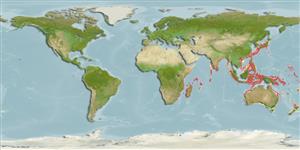>
Callionymiformes (Dragonets) >
Callionymidae (Dragonets)
Etymology: Bathycallionymus: Greek, bathys = deep + Greek, kalos, kallos = beauty + Greek, onyma, -atos = name (Ref. 45335).
More on author: Günther.
Environment: milieu / climate zone / depth range / distribution range
Ökologie
seewasser demersal; tiefenbereich 180 - 290 m (Ref. 75992). Temperate
Indo-West Pacific: Zanzibar (Ref. 26165) to southern Japan, East China Sea, and the Banda Sea (Ref. 559).
Size / Gewicht / Alter
Maturity: Lm ? range ? - ? cm
Max length : 16.0 cm SL Männchen/unbestimmt; (Ref. 559)
Rückenflossenstacheln (insgesamt) : 4; Rückenflossenweichstrahlen (insgesamt) : 9 - 10; Afterflossenstacheln: 0; Afterflossenweichstrahlen: 9. First dorsal fin elongate and filamentous. Tip of the anterior branch of last dorsal ray branched. Third membrane of the 1st dorsal fin with lunate blotch. Anal fin pale in male, faintly dusky at lower margin in the female.
Found on the shelf edge (Ref. 11230).
Life cycle and mating behavior
Geschlechtsreife | Fortpflanzung | Ablaichen | Eier | Fecundity | Larven
Masuda, H., K. Amaoka, C. Araga, T. Uyeno and T. Yoshino, 1984. The fishes of the Japanese Archipelago. Vol. 1. Tokai University Press, Tokyo, Japan. 437 p. (text). (Ref. 559)
IUCN Rote Liste Status (Ref. 130435: Version 2024-2)
Bedrohung für Menschen
Harmless
Nutzung durch Menschen
Tools
Zusatzinformationen
Download XML
Internet Quellen
Estimates based on models
Preferred temperature (Ref.
123201): 12.1 - 23, mean 15.2 °C (based on 93 cells).
Phylogenetic diversity index (Ref.
82804): PD
50 = 1.0000 [Uniqueness, from 0.5 = low to 2.0 = high].
Bayesian length-weight: a=0.00794 (0.00362 - 0.01742), b=2.81 (2.63 - 2.99), in cm total length, based on LWR estimates for this (Sub)family-body shape (Ref.
93245).
Trophic level (Ref.
69278): 3.4 ±0.5 se; based on size and trophs of closest relatives
Widerstandsfähigkeit (Ref.
120179): mittel, Verdopplung der Population dauert 1,4 - 4,4 Jahre. (Preliminary K or Fecundity.).
Fishing Vulnerability (Ref.
59153): Low vulnerability (10 of 100).
